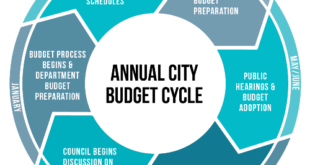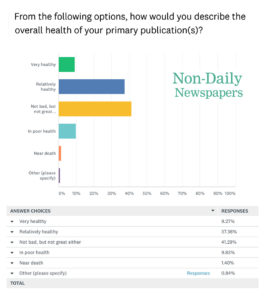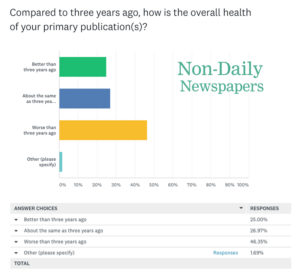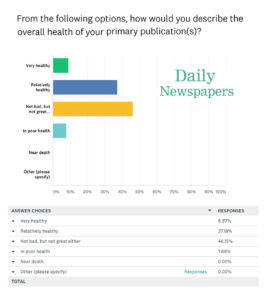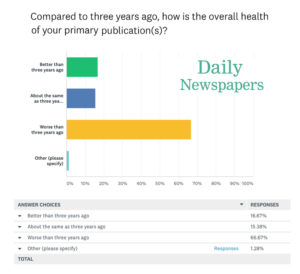By Kevin Slimp
I’ve noticed a definite trend lately. It might be related to the increased number of industry activities I’m involved in these days, or perhaps it’s just be one of those things that can’t be explained. Whatever the reason, I’ve been getting a lot more email over the past few months.
Over the course of an hour today, I received three emails from publishers who wanted to say “thanks.” One was thanking me for the information they received in a recent webinar. Another wanted to express their appreciation for some information I shared at a convention they attended last week. The third wrote to thank me for conducting surveys and sharing results with publishers “like me.”

I will leave it to you to draw your own conclusions but from where I’m sitting it’s obvious newspaper publishers, editors and other journalists are paying much closer attention to what’s happening in the industry these days. As a result, I’m hearing from a lot more of you.
As I sat in front of my computer this morning to continue looking over numbers from my most recent survey of newspaper publishers and editors, I began to break the information down into more specific areas. Filtering the results between regions, size of newspapers, and ownership, I began to see obvious differences in newspaper health based on these divisions.
Interestingly, the general responses to the question, “How would you describe the overall health of your primary publication,” didn’t vary much related to circulation or frequency of publication. A large majority of newspapers of all sizes and types answered either “Not bad, but not great,” or “Relatively healthy.”
What caught my eye were the responses to another question, “Compared to three years ago, how is the overall health of your primary publication?” This is when things began to get more interesting.
As I broke the responses down between daily and non-daily newspapers, a statistically significant difference became apparent. Compared to their overall health three years ago, roughly 52 percent of respondents from non-daily papers answered their newspapers were in “about the same” or “better” health compared to three years ago. While that might sound like good news, 46 percent of non-daily papers report being in worse health than three years ago. I suppose it’s a “glass half full” proposition.
Examining responses from daily newspaper publishers might make some non-daily folks breath a sigh of relief that their numbers are on the “full” side of the glass. Two-thirds of daily respondents indicate their papers are in worse health than three years ago.
You might ask yourself how most newspapers report their health as “Not bad,” or “Relatively healthy,” if the majority of dailies seem to be experiencing worse health than three years ago.
The answer is simple. While most newspapers are still doing well, many are not in as good of shape as they were three years ago. That is especially true for daily newspapers.
The results aren’t all doom and gloom for daily papers. Nearly 17 percent of dailies report being in better health than three years ago.
Last week, while working on-site with a daily newspaper in Tennessee, I had the opportunity to discuss the newspaper’s health over lunch with the publisher and another long-time manager. I mentioned there seemed to be a positive “vibe” at their newspaper.
They told me about their readers. Their numbers haven’t been dropping. They described the new magazines and other products they’ve successfully launched.
I asked about the differences I witnessed at their paper compared to some other dailies I’d visited recently in Tennessee. Their responses, which might seem obvious to some, were filled with wisdom.
“Our readers know they are getting a good product. We haven’t slashed pages. We haven’t cut our staff to the bone.”
I liked the next thing the publisher said, “They know they can trust us.”
He mentioned a time when he worked for a large group a few years ago and how different it is to work at a paper where decisions can be made based on what’s best for the long-term health of the newspaper.
I could make my own assumptions concerning the less positive responses from daily papers in this latest survey, but for now I’ll share this bit of wisdom gained after working with thousands of papers of all sizes. It’s not about daily vs. non-daily. It’s not about local ownership vs. corporate ownership. It’s about trust.
State of Newspapers Website
In February, I began work on a new website dedicated to sharing news of interest to our industry. StateOfNewspapers.com kicks off April 1, with stories related to weekly, daily and metro newspapers in the U.S. and Canada. As word began to spread that I was working on this project, I heard from website developers, publishers, editors and journalists throughout both countries, offering to lend a hand.
Beginning April 1, visit StateofNewspapers.com and see what I’ve been implementing. So far, the reviews have been very positive. If you have a story – or link to a story – you think would be of interest to others in the newspaper business, be sure to send it my way.
Reach Kevin at kevin@kevinslimp.com
 Nevada Press Association The best in Nevada journalism since 1924
Nevada Press Association The best in Nevada journalism since 1924
